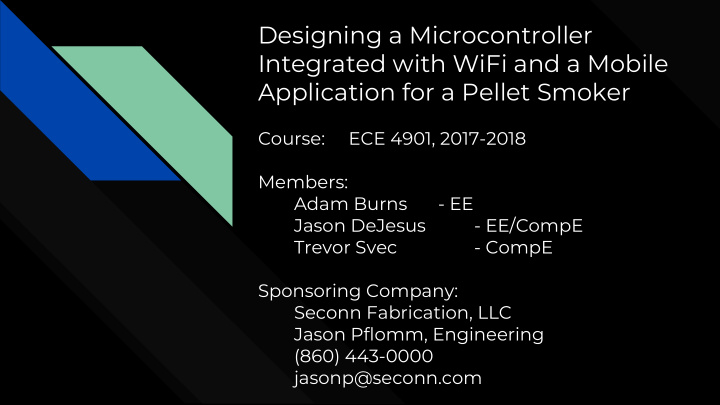



Designing a Microcontroller Integrated with WiFi and a Mobile Application for a Pellet Smoker Course: ECE 4901, 2017-2018 Members: Adam Burns - EE Jason DeJesus - EE/CompE Trevor Svec - CompE Sponsoring Company: Seconn Fabrication, LLC Jason Pflomm, Engineering (860) 443-0000 jasonp@seconn.com
Seconn Fabrication Adam Trevor Jason Manufacturing group based ● in southern New England Precision sheet metal ● Robotics ● Automation ● Daughter company ● Myron Mixon Smokers ○
Myron Mixon
Summary The existing microcontroller has reduced functionality and is ● limited in scope Delivering a new microcontroller that exceeds the capabilities of ● the current microcontroller in use We intend to reverse engineer the major components of the old ● microcontroller to provide us with a path for designing and implementing a new microcontroller The next major goal will be to implement a mobile application in ● use with integrated WiFi/Bluetooth protocols
Background Existing Microcontroller - PIC16F882 Digital Thermostat Kit by Ortech ● Cost to Purchase = $45 ● Three Digit Temperature Display ● Front Panel Cook Control ● Eight Cook Temperature Settings - 180 ° - 375 ° F ● Sixteen Smoke Settings for Smoke Control ● Cool Down Cycle ● Several Sensor Indicators ●
Problem One of the main obstacles with the existing design is lack of WiFi ● and mobile application compatibility Currently no module on the existing microcontroller to serve ● these functions Poor feedback loops for retaining heat on smoker ● Market demand for extended cooking and smoking functionality ●
Microcontroller Microcontroller Cost CPU Memory Video Wireless Raspberry Pi 3 $35 1.2 GHz microSD HDMI / LCD WiFi / Model B 64-bit Quad Core Card Bluetooth Onboard Arduino Uno R3 $28 16 MHz crystal Internal LCD WiFi / Flash Bluetooth Memory Offboard of 32 KB Beaglebone Rev $67 1 GHz 4 GB HDMI / LCD WiFi / C eMMC Bluetooth Offboard
WiFi Offboard Device ESP8266 NodeMCU ● $9 ● Built-in Micro-USB ● Wireless 802.11 Supported ● Arduino Compatible ● Serial Module ●
LCD Screens LCD Screen Cost Size Touch Interface OSOYOO Touch $30 3.5” Yes HDMI Screen LCD up to 1920*1280 Basic 16x2 $15 16x2 No 11 Pin IO Character LCD Characters
LCD Screens OSOYOO Touch Screen LCD
LCD Screens Basic 16x2 Character LCD
Wireless Protocols WiFi: 802.11a/b/g ● Frequency Band: 2.4 GHz ● Nominal Range: 100 m ● Channel Bandwidth: 22 MHz ● Max Signal Rate: 54 Mb/s ●
Wireless Protocols Bluetooth: 802.15.1 ● Frequency Band: 2.4 GHz ● Nominal Range: 10 m ● Channel Bandwidth: 1 MHz ● Max Signal Rate 1 Mb/s ●
Wireless Configurations Direct Access - Indirect Access - Bluetooth or WiFi WiFi
Budget Track 1 Track 2 Track 3 Final product includes: ● Raspberry Pi 3 Model B Arduino Uno R3 - $28 Raspberry Pi 3 Digital Microcontroller ○ - $35 Model B - $35 w/ WiFi Power Board ○ OSOYOO Touch Screen Basic 16x2 Character LCD Basic 16x2 Character Display ○ LCD - $30 - $10 LCD - $10 App ○ should be no more than ● $100-$150 Onboard WiFi/Bluetooth Offboard WiFi - ESP8266 Onboard Prototype can be more ● NodeMCU - $9 WiFi/Bluetooth Price not including power ● components from existing controller Total = $65 Total = $47 Total : $45
Solution Redesign the microcontroller by programming existing mainstream ● microcontroller (raspberry pi, arduino, etc) Use the digital IO from a microcontroller with a development board to ● control all the power components on the existing microcontroller Utilize WiFi on the new microcontroller to interface with a mobile ● application We would keep redesigning the power components to a bare ● minimum in order to use the mainstream microcontroller as the main controller.
Project phases, timing, milestones - 1st Semester September Contact/Meet with Advisor and Sponsor ● Speak about scope of project ○ Set up regular meetings and meeting times ● Project Statement ● October Weekly meetings with Advisor / Sponsor begin ● Set project expectations ● Economic, time, and manpower constraints ○ Research existing micro-controllers / micro-controller components ● November Creation of week by week timeline ● Project Proposal Due ● Purchase Prototyping Materials ● Receive grill(s) ● December Test integration of new microcontroller in system ●
Project phases, timing, milestones - 2nd Semester January Re-examine timeline and adjust accordingly ● Major follow up with sponsor regarding progress and goals ● February Demonstrate functionality of new microcontroller system ● Should be on par with previous system ○ Begin App Prototyping ● March Design and implement enhanced functionality ● WiFi, LCD screen, Recipes ○ April Demonstrate ability to cook different recipes effectively ●
Questions? Comments?

Recommend
More recommend